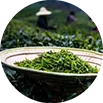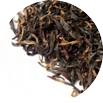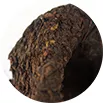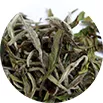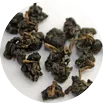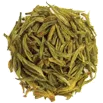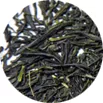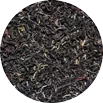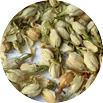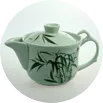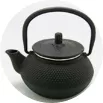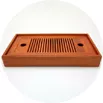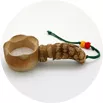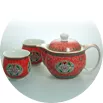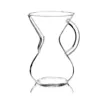Yang Hu, or “raising” the Yixing teapot
So you bought a clay pet for your home. The preparation has taken place, the tea is flowing, the aroma is rising, the hands are warming up against the surface, the patina is slowly forming… In short, an experience.
But if you want your pet to continue to have nice “fur” and not look like a street outcast, you have to take proper care of it. Pour tea over it, clean it, polish it, etc. Otherwise, it can end up like one of those monstrosities you see in most teahouses – covered in what often resembles a layer of tar and with a stinky inside. You have certainly met such “monsters” before, whether in a tea shop or perhaps at the home of an acquaintance who makes all the teas in one pot, leaves the leaves in it for a week, rinses it only with tap water and leaves it to dry on a wet and dirty rag in the kitchen. Such teapots stink even when dry, and the tea prepared in them acquires an unpleasant aftertaste.
The Yixing teapot can significantly enhance the taste properties of the tea, if it has been well chosen and used correctly. It is therefore important not only to dedicate the teapot to a certain tea with regard to the properties of the material and shape, but also to ensure that the properties of the teapot improve over time. The well-known Chinese superstition that if you use the Yixing Zi Sha pot for a really long time, you can pour clean water into it and pour out the tea is of course just a superstition, but it describes the absorption properties of “yixing” very well. In the case of high-quality material, after several years of constant use of the teapot, you can tell by the smell which type of tea was prepared in it. But if you make several different teas in it, the last one prepared often has a hint of the previous one.
The Chinese have a lot of different traditions and specific terminology dedicated to this pottery. And not only in connection with its production, but also with its use and care. In fact, everything that could be invented has been around for a long time. We can only occasionally improve something in connection with modern knowledge.
Now for why I used the word “pet” at the beginning. The whole process of taking care of the teapot, the whole long-term supervision of its journey, is called “Yang Hu” (养壶), which literally means “rising the teapot” (taking care of the teapot). The term Yang is most often used in connection with animal behavior. The teapot is therefore a kind of pet in this case.
Care in connection with tea:
1) The best and most perfect option is to prepare ONLY one specific tea in the teapot, or to prepare a group of teas with similar taste characteristics in it (e.g. Phoenix teas or oolongs from southern Fujian). In short, not to mix different taste. As a result, the teapot will absorb only similar aromas and in the future will be able to improve the taste of these particular teas.
2) Always heat the teapot before making tea. If it is made of a higher quality material that expands a lot with heat (a dry teapot filled with boiling water hisses or crackles), take some time and heat it gradually, first with warm water and only then with hot and boiling water.
3) During tea making, pour not only water over the teapot, but also the remains of the tea (if you have any left over, of course).
4) Yixing Zi Sha does not like tea crumbs and stains, so brush her with a special tea brush during tea making. It is called “Yang Hu Bi”, literally “teapot raising brush”. This tea accessory is not only an essential part of Gong Fu Cha, but also an important helper in taking care of the surface of the teapot. Through the brush, you not only show attention to the Cha Hu (teapot) as “father” (in English we’d rather say mother, but for the Chinese it’s father) and tea educator, but you also transfer Qi energy to the drink itself. A good brush is therefore not artificial. Yang Hu Bi used to be made mainly from the fur of Ussurian tigers, but now that their population has almost disappeared, they are mostly made from the fur of squirrels.
5) During tea making, the teapot is usually located on the teatray. However, another accessory can be used and placed in a special bowl called Cha Chi (茶池) – “Tea pond (reservoir, dam, pond)”. Gradually, the tea will accumulate in this bowl, which will be poured out every time you close the teapot with the lid, plus the possible residues with which you pour on the teapot. It is possible to leave the teapot in this “pond” for some time even after drinking tea, and rub the surface with a brush. It is probably the fastest way to properly “season” the teapote. Just don’t forget to take care of the tea spots and circles that can appear on the surface when the teapot is not completely immersed in the tea.
Preparing a new teapot.
At the very beginning, I want to say that the following advice is applicable and makes sense only if it is a real high-quality Zi Sha teapot from Yixing. In the event that the teapot is purchased from a cheap online store, such as Yunnan Sourcing (selling officially long-extinct types of clay, and in fact teapot are mostly cheap clay mixed with kaolin, as well as fakes from Guangdong clay), or you own a “teapot shaped flower pot” for a few bucks from a local store, so these tips are difficult to apply… I mean, they can be applied, but without results. Only genuine Yixing Zi Sha has the correct composition and porosity, and only in this case will the preparation raise your watering can to a completely different level.
What you should know before you start:
– Zi Sha is a semi-stoneware, after processing and firing it is suitable for making tea and does not need any glaze.
– It is dispersive (consists of small uniform particles), yet still quite porous and therefore able to absorb tea (up to 4% of its own weight). The purpose of “seasoning” will be mainly to prepare the pores of the teapot for better absorption of tea and aroma.
– It is quite hard, quality Zi Sha cannot be scratched with a knife or file, but it is fragile and will break easily when hit.
– New teapots sometimes have a kind of internal tension in them after processing, so it can happen that a new teapot cracks after pouring boiling water (however, this rarely happens, it happens most often in the case of Zhu Ni clay).
– Before you start the preparation, you have to decide which tea (or group of teas) you will dedicate the teapot to. You will then boil it in this tea.
– Purely theoretically, a new teapot can be easily prepared by infusing very strong tea in it several times overnight. However, the preparation described below is much more effective, it reliably cleans and prepares the teapot. After boiling, the residual pieces of clay left after its production sometimes peel off from the teapot. After proper preparation, the teapot also “ages” faster.
What you will need:
– a teapot
– cleaning tools – wooden stick or toothpick, metal wire, rough clean sponge or hard toothbrush, teaspoon
– a pot
– 15-20g of tea
– closing tea strainers
– linen cloth for wrapping the teapot and lid, something to secure the cloth (wire, paper clip)
– several water containers
– water thermometer
– good and strong bamboo tweezers (desirable, but not necessary)
And we proceed to the Yixing seasoning itself:
1) Cleaning
First, the teapot must be properly cleaned. Scrub it all over with a clean wet sponge. The water used to rinse the teapot should be neither cold nor too hot, preferably around 50°C. The teapot can also be scrubbed with a brush, don’t be afraid to scrub thoroughly. Zi Sha is very hard, almost impossible to scratch. However, you must not use any cleaning agents.
You must also clean the mouthpiece and the hole in the lid properly. Use a skewer or a toothpick to do this. Possibly a metal wire. Many teapots have lumps and pieces of clay in these places after processing. They can be removed if you press them lightly, but be careful not to break, for example, the edge of the spout (it can be very thin on some teapots). Lumps and bits of clay are also found inside, the best way to remove them is to scrub the inside of the teapot with a metal teaspoon. Don’t be alarmed if the spoon leaves shiny lines, it’s just the soft metal rubbing against the harder semi-stoneware. It disappears after boiling, or several uses. I must also point out that some pieces of clay are to strong to remove them, they usually fall off after boiling or with time. Therefore, after boiling, you can try to repeat this “removal of pieces”.
2) Flushing
Rinse the teapot with water around 50°C 5-6 times. No cleaning agents. Let the teapot dry.
3) Pore preparation
This is the most important and at the same time the most difficult part of the preparation. In order for the pores to expand properly and be able to absorb tea, they need to be expanded. Therefore, we will rinse the teapot in water of different temperatures. These “water procedures” will not only open the pores, but also help to remove any internal tension in the teapot after production. Proceed with caution and be especially careful when filling the teapot for the first time.
Fill the teapot with water around 80°C, don’t forget to pour it all over the outside as well. This heats the inside and outside evenly, reducing the chance of cracking. When the surface of the teapot dries a little, pour out the water and fill it with water around 40°C. Wait a minute.
The next step is to pour water around 90°C and then 40°C. Do not forget to water the outer surface of the teapot when pouring.
Proceed as follows:
– 100°C – 50°C
– 100°C – 40°C
– 100°C – 30°C
– 100°C – 20°C
– 100°C – the coldest water that flows from your tap – it is usually around 12°C.
This procedure is written for the most sensitive clay ever (Zhu Ni). If your teapot is made of more durable clay, you can shorten this procedure (fill the watering can with one hundred – then with water around 40°C, again with one hundred – room temperature water, one hundred – the coldest).
During these “water procedures”, listen carefully to the sounds your teapot makes. If it hisses extra strongly or e.g. sounds like it’s cracking, take your time. Leave the water poured into it for longer than a minute, increase the temperature difference gradually, just take your time.
4) Boiling
As I already wrote, you can just let the strong tea infuse overnight in the teapot. However, boiling cleans the kettle better. After infusing in it, you can immediately make tea, which will have the appropriate quality. Otherwise, the first 5-10 tea preparations may not have the right taste.
Wrap the teapot and the lid separately in a clean linen cloth (it is good to have a cloth made of natural material dedicated only to boiling teapots). Secure the edges of the cloth with wire. Put the teapot and the lid in the saucepan, they need to be wrapped separately so that they don’t touch each other during boiling. The teapot must lie with the neck upwards. The lid must lie with the bottom up, otherwise bubbles will form under it and the lid will jump. Fill the teapot with hot water and let it boil on a low flame. As soon as the water starts to boil, immerse the tea in the strainer.
Important!!! After 10-15 minutes, you have to take the leaves out of the saucepan. During longer boiling, unhealthy compounds are excreted from the tea leaves. Specifically, it concerns guanine and guanidine, which are harmful to the nervous system. When boiled for longer than 10-15 minutes, guanine is secreted from the leaves in larger quantities. During its subsequent breakdown (within a few hours), no less harmful guanidine is formed. We can remove this by boiling, but during boiling the leaves, even more guanine is excreted, which then breaks down into guanidine… In short -do not keep boiling it. And boiling the teapot, which has strong absorbent properties, in this noxious infusion is not good.
Addendum: with the guanine and guanidine, it is not quite certain. They are mentioned in a lot of sources, but there is probably no concrete research that would focus explicitly on this question.
So pull out the strainer with the leaves, and boil the teapot only in the “broth” that remains.
Continue boiling for another hour.
5) Leaching in the infusion
After an hour of boiling, turn off the stove and leave the teapot in this tea broth overnight. The next morning, take the teapot out of the infusion, rinse and let it dry. If a white patina forms on the teapot (green teas often leave it, for example), then rinse it with boiling water and scrub with a cloth to remove it.
Now the teapot is ready, you can have tea!
© 2010 Maxim Obukhov, edited


